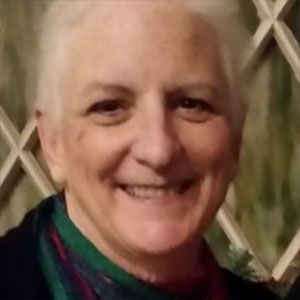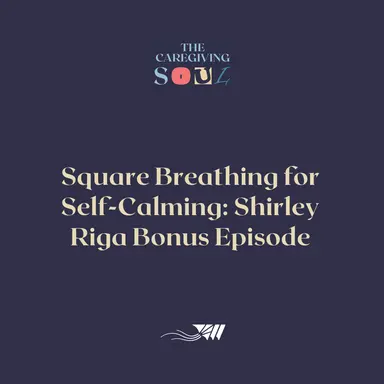In episode 6 of The Caregiving Soul, Dannelle speaks with Shirley Riga about some helpful strategies and tools she learned to manage fear and anxiety while dealing with uncertainty and loss.
One of the tools covered was Square Breathing – a self-regulating tool that Shirley highly recommends. In this bonus mini-episode, we dive into the what, the why, and the how of Square Breathing so that you can apply it to your life as it makes sense.
What is Square Breathing?
Square breathing, also called Box Breathing, is a breath-based, self-calming tool taught to United States Navy SEALS to manage overwhelming situations. It is a tried and true method that can be so helpful in a variety of scenarios.
The Square Breathing technique originates from the yogic practice of pranayama or focusing on the breath.
The reason for its common name, Box Breathing is because a square has four sides, which are represented by the breath – four counts to breathe in, four counts of holding your breath, four counts to exhale, and four counts of holding your breath after the exhale.
Why is Square Breathing impactful?
Caregiving can be a difficult task, with many stressful moments. Breathwork, such as Square Breathing activates the parasympathetic nervous system, which is the system responsible for rest, calming down the sympathetic nervous system’s “fight or flight response”.
When we are anxious, our breaths our short and shallow. Taking a moment to focus on deep, slow breathing through techniques such as Square Breathing calms the mind and allows us to feel more grounded in the present moment.
Overall, Square Breathing can result in the following:
- Lower stress levels
- Boosted mood
- Decreased blood pressure and heart rate
- Improved sleep
How do you practice Square Breathing?
Breathe in through your nose for four counts
Hold for four counts
Exhale for four counts
And hold for four counts
Continue breathing like this until you feel a deeper sense of calm and your heart rate goes down.
This technique can feel a bit awkward at first, especially if you are not familiar with breathwork. But if you’re determined to find more healthful ways through the madness, you might find that you don’t really care if it’s awkward. Because the fact is, everything’s awkward right now anyway! So keep practicing!
We hope you found this technique valuable to add to your caregiving toolbox.
Tips for Square Breathing in Practice
- Practice with good posture
- Try the lengthen the count over time
- Set a clear intention
- Combine Square Breathing with other pranayama practices
- Develop a habit of stepping back throughout your day to re-center and align your energy
Additional Resources
About Shirley Riga

Shirley Riga is the author of two books focused on surviving and thriving as a caregiver while living with her daughter’s chronic illness. An advocate for self-care and a teacher of meditation, Riga is a Certified Psychosynthesis Counselor, a Spiritual Director and a Psychic Medium. Riga came to this work after a lifetime of intense challenges –alcoholic family home, childhood abuse, toxic relationships, chronic illness, and the death of her spouse and her daughter. She struggled with poor self-esteem, immobilizing fear, and lack of a belief in a Higher Power. She learned to turn around challenges into lessons and tools, rebuilding herself while witnessing the firsthand positive changes rippling down to her children. Riga works with clients and groups as a coach, motivational teacher and trance healer sharing the process of finding empowerment through adversity.
Transcript
Hello and welcome to The Caregiving Soul. I’m your host Dannelle LeBlanc.
Read More
Today we’re talking about Square Breathing – A self-regulating technique that Shirley Riga and I discussed in our conversation about caring for a child with chronic illnesses. In addition to Square Breathing, we cover several of the tools she learned to center herself in demanding and stressful situations, so if you have not had a chance to listen to that episode, I recommend you check it out.
It’s become increasingly clear that people, systems, and old ways of doing things are malfunctioning under overwhelming pressure. We’re talking about square breathing as one way to better manage the impact on our physical and emotional wellbeing – which are connected. What affects us emotionally leaves an imprint in the body, whether or not we initially notice it. So it’s more important than ever that we know and practice ways to process stress that are internally-sourced, and accessible wherever we may be.
In fact, Square breathing, also called Box Breathing is taught to United States Navy SEALS to manage overwhelming situations and is a tried and true method that can be so helpful in a variety of scenarios.
This breathing technique originates from the yogic practice of pranayama or focusing on the breath.
In square breathing, each side we visualize is represented by the mindful breath we take.
Let’s try it together:
· Breathe in through your nose for four (Dannelle counts)
· Hold for four (Dannelle counts)
· Exhale for four (Dannelle counts)
· And hold for four (Dannelle counts)
And Again:
· Breathe in through your nose for four (Dannelle counts)
· Hold for four (Dannelle counts)
· Exhale for four (Dannelle counts)
· And hold for four (Dannelle counts)
We can continue until we feel more centered, you’ll feel your body respond by slowing the heart rate, a greater sense of calm, and maybe enough clarity to see the next step, or how we want to respond to a stressor.
Scientifically speaking, breathwork activates the parasympathetic nervous system, which is the system responsible for rest, calming down the sympathetic nervous system’s “fight or flight response”.
When we are anxious, our breaths are short and shallow. Taking a moment to focus on deep, slow breathes through techniques such as square breathing calms the mind and allows us to feel more grounded in the present moment.
This technique can feel a bit awkward at first, especially if you are not familiar with breathwork. But if you’re like me and determined to find more healthful ways through the madness, you might find that you don’t really care if it’s awkward. Because the fact is, everything’s awkward right now anyway! So keep practicing!
I hope you found this technique valuable to add to your caregiving toolbox.
Every episode of The Caregiving Soul has a page on empoweredus.org, where you can find the extended show notes – including transcripts and relevant resource links.
If you would like to share your own tips related to this topic or connect with us, visit the Empowered Us Contact page or reach out to us on our social channels.
The Caregiving Soul is an Empowered Us Original presented by Good Days, hosted by me, Dannelle LeBlanc. If you liked this episode, be sure to rate and subscribe to this show wherever you get your podcasts.
And remember, the right care includes care for you.
Read Less
Recommended this Week

How to improve healthy food access in marginalized communities.




